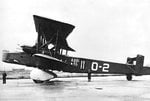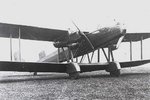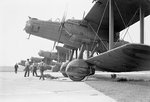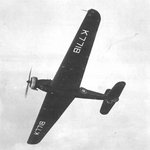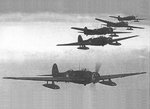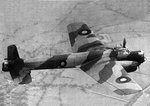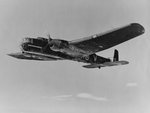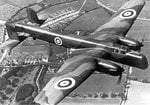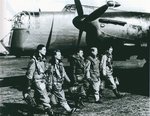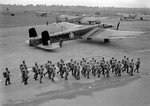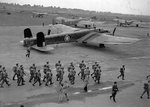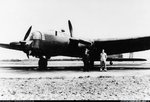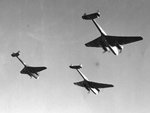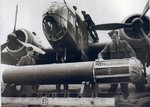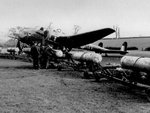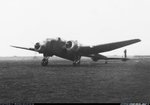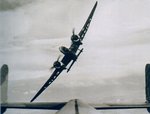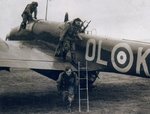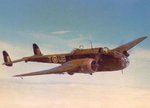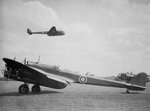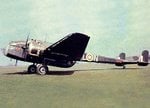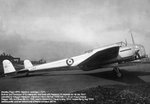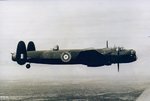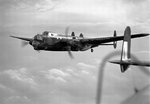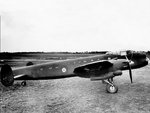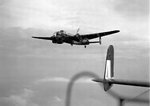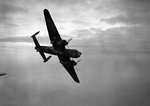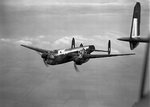RAF Bomber Command was the organisation that controlled the RAF's bomber forces from 1936 to 1968. During World War II, the command destroyed a significant proportion of Nazi Germany's industries and many German cities, and in the 1960s was at the peak of its postwar power with the V bombers and a supplemental force of Canberra light bombers. RAF Bomber Command had 19 Victoria Cross winners. In August 2006, a memorial was unveiled at Lincoln Cathedral. A Memorial is also proposed for Green Park in London to highlight the price paid by the aircrews.
At the start of World War II in 1939, Bomber Command faced three problems. The first was lack of size; Bomber Command was not large enough to effectively attack the enemy as a pure, stand-alone strategic force. The second was rules of engagement; at the start of the war, the targets allocated to Bomber Command were not wide enough in scope. The third problem was the Command's lack of technology; specifically radio or radar derived navigational aids to allow accurate target location and thus bombing.
When the war began on 1 September 1939, Franklin D. Roosevelt, President of the then-neutral United States, issued an appeal to the major belligerents to confine their air raids to military targets. The French and British agreed to abide by the request, which included the provision "that these same rules of warfare will be scrupulously observed by all of their opponents". The United Kingdom's policy was to restrict bombing to military targets and infrastructure such as ports and railways which were of military importance. While acknowledging that bombing Germany would cause civilian casualties, the British government renounced deliberate bombing of civilian property (outside combat zones) as a military tactic. The British abandoned this policy at the end of the Phony War on 15 May 1940, one day after the Rotterdam Blitz.
The British Government did not want to violate its agreement by attacking civilian targets outside combat zones, and the French were even more concerned lest Bomber Command operations provoke a German bombing attack on France. Since the Armée de l'Air had few modern fighters and no defence network comparable to the British chain of radar stations, France was effectively prostrate before the threat of a German bombing attack. The final problem was lack of good enough aircraft. The main Bomber Command workhorses at the start of the war had been designed as tactical-support medium bombers, and none of them had enough range or ordnance capacity for anything more than a limited strategic offensive.
Bomber Command became even smaller after the declaration of war. No. 1 Group, with its squadrons of Fairey Battles, left for France to form the Advanced Air Striking Force. This was for two reasons; to give the British Expeditionary Force some air striking power, and to allow the Battles to operate against German targets - it lacked the range to do so from British airfields. The Sitzkrieg (or Phony War) mainly affected the army. However, to an extent, Bomber Command too saw little combat during the first few months of hostilities. Bomber Command flew many operational missions, and lost aircraft, but it did virtually no damage to the enemy. Most of the missions either failed to find their targets, or were leaflet-dropping missions (the first flights by RAF bombers over the German homeland were only to drop propaganda leaflets at night). The attack in the west in May 1940 changed everything.
The Fairey Battles of the Advanced Air Striking Force were partially disabled by German strikes on their airfields at the opening of the invasion of France. However, far from all of the force was caught on the ground. The Faireys proved to be horrendously vulnerable to enemy fire. Many times, Battles would set out to attack, and be almost wiped out in the process. Due to French paranoia about being attacked by German aircraft during the "Phony War", the Battle force had actually trained over German airspace at night.
Following the German Rotterdam Blitz of 14 May 1940, RAF Bomber Command was authorized to attack German targets east of the Rhine on May 15, 1940; the Air Ministry authorized Air Marshal Charles Portal to attack targets in the Ruhr, including oil plants and other civilian industrial targets which aided the German war effort, such as blast furnaces (which at night were self-illuminating). The first attack took place on the night of 15/16 May, with 96 bombers setting off to attack targets east of the Rhine, 78 of which were against oil targets. Of these, only 24 claimed to have found their targets. Bomber Command's strategic bombing campaign on Germany had thus begun.
Bomber Command itself soon fully joined in the action. With the rapid collapse of France, invasion of England seemed a clear and present danger. As its part in Battle of Britain, Bomber Command was assigned to pound the invasion barges and fleets assembling in the Channel ports. This was much less high profile than the battles of the Spitfires and Hurricanes of RAF Fighter Command, but still vital and dangerous work. From July 1940 to the end of the year, Bomber Command lost nearly 330 aircraft and over 1,400 aircrew killed, missing or captured.
Bomber Command was also indirectly responsible, in part at least, for the switch of Luftwaffe attention away from Fighter Command to bombing civilian targets. A German bomber on a raid got lost due to poor navigation and bombed London. Churchill consequently ordered a retaliatory raid on the German capital of Berlin. The damage caused was minor, but the raid sent Hitler into a rage. He ordered the Luftwaffe to level British cities, thus precipitating the Blitz. Like the United States Army Air Forces later in the war, Bomber Command had first concentrated on a doctrine of "precision" bombing in daylight. However, when well-organised German defence cut several British raids to pieces in late 1939, a switch to night attack tactics was forced upon the Command. The problems of enemy defences were then replaced with the problems of simply finding the target. It was common in the early years of the war for bombers relying on dead reckoning navigation to miss entire cities. Surveys of bombing photographs and other sources published during August 1941 indicated that less than one bomb in ten fell within 5 miles (8.0 km) of its intended target. One of the most urgent problems of the Command was thus to develop technical navigational aids to allow accurate bombing.
At the start of World War II in 1939, Bomber Command faced three problems. The first was lack of size; Bomber Command was not large enough to effectively attack the enemy as a pure, stand-alone strategic force. The second was rules of engagement; at the start of the war, the targets allocated to Bomber Command were not wide enough in scope. The third problem was the Command's lack of technology; specifically radio or radar derived navigational aids to allow accurate target location and thus bombing.
When the war began on 1 September 1939, Franklin D. Roosevelt, President of the then-neutral United States, issued an appeal to the major belligerents to confine their air raids to military targets. The French and British agreed to abide by the request, which included the provision "that these same rules of warfare will be scrupulously observed by all of their opponents". The United Kingdom's policy was to restrict bombing to military targets and infrastructure such as ports and railways which were of military importance. While acknowledging that bombing Germany would cause civilian casualties, the British government renounced deliberate bombing of civilian property (outside combat zones) as a military tactic. The British abandoned this policy at the end of the Phony War on 15 May 1940, one day after the Rotterdam Blitz.
The British Government did not want to violate its agreement by attacking civilian targets outside combat zones, and the French were even more concerned lest Bomber Command operations provoke a German bombing attack on France. Since the Armée de l'Air had few modern fighters and no defence network comparable to the British chain of radar stations, France was effectively prostrate before the threat of a German bombing attack. The final problem was lack of good enough aircraft. The main Bomber Command workhorses at the start of the war had been designed as tactical-support medium bombers, and none of them had enough range or ordnance capacity for anything more than a limited strategic offensive.
Bomber Command became even smaller after the declaration of war. No. 1 Group, with its squadrons of Fairey Battles, left for France to form the Advanced Air Striking Force. This was for two reasons; to give the British Expeditionary Force some air striking power, and to allow the Battles to operate against German targets - it lacked the range to do so from British airfields. The Sitzkrieg (or Phony War) mainly affected the army. However, to an extent, Bomber Command too saw little combat during the first few months of hostilities. Bomber Command flew many operational missions, and lost aircraft, but it did virtually no damage to the enemy. Most of the missions either failed to find their targets, or were leaflet-dropping missions (the first flights by RAF bombers over the German homeland were only to drop propaganda leaflets at night). The attack in the west in May 1940 changed everything.
The Fairey Battles of the Advanced Air Striking Force were partially disabled by German strikes on their airfields at the opening of the invasion of France. However, far from all of the force was caught on the ground. The Faireys proved to be horrendously vulnerable to enemy fire. Many times, Battles would set out to attack, and be almost wiped out in the process. Due to French paranoia about being attacked by German aircraft during the "Phony War", the Battle force had actually trained over German airspace at night.
Following the German Rotterdam Blitz of 14 May 1940, RAF Bomber Command was authorized to attack German targets east of the Rhine on May 15, 1940; the Air Ministry authorized Air Marshal Charles Portal to attack targets in the Ruhr, including oil plants and other civilian industrial targets which aided the German war effort, such as blast furnaces (which at night were self-illuminating). The first attack took place on the night of 15/16 May, with 96 bombers setting off to attack targets east of the Rhine, 78 of which were against oil targets. Of these, only 24 claimed to have found their targets. Bomber Command's strategic bombing campaign on Germany had thus begun.
Bomber Command itself soon fully joined in the action. With the rapid collapse of France, invasion of England seemed a clear and present danger. As its part in Battle of Britain, Bomber Command was assigned to pound the invasion barges and fleets assembling in the Channel ports. This was much less high profile than the battles of the Spitfires and Hurricanes of RAF Fighter Command, but still vital and dangerous work. From July 1940 to the end of the year, Bomber Command lost nearly 330 aircraft and over 1,400 aircrew killed, missing or captured.
Bomber Command was also indirectly responsible, in part at least, for the switch of Luftwaffe attention away from Fighter Command to bombing civilian targets. A German bomber on a raid got lost due to poor navigation and bombed London. Churchill consequently ordered a retaliatory raid on the German capital of Berlin. The damage caused was minor, but the raid sent Hitler into a rage. He ordered the Luftwaffe to level British cities, thus precipitating the Blitz. Like the United States Army Air Forces later in the war, Bomber Command had first concentrated on a doctrine of "precision" bombing in daylight. However, when well-organised German defence cut several British raids to pieces in late 1939, a switch to night attack tactics was forced upon the Command. The problems of enemy defences were then replaced with the problems of simply finding the target. It was common in the early years of the war for bombers relying on dead reckoning navigation to miss entire cities. Surveys of bombing photographs and other sources published during August 1941 indicated that less than one bomb in ten fell within 5 miles (8.0 km) of its intended target. One of the most urgent problems of the Command was thus to develop technical navigational aids to allow accurate bombing.

